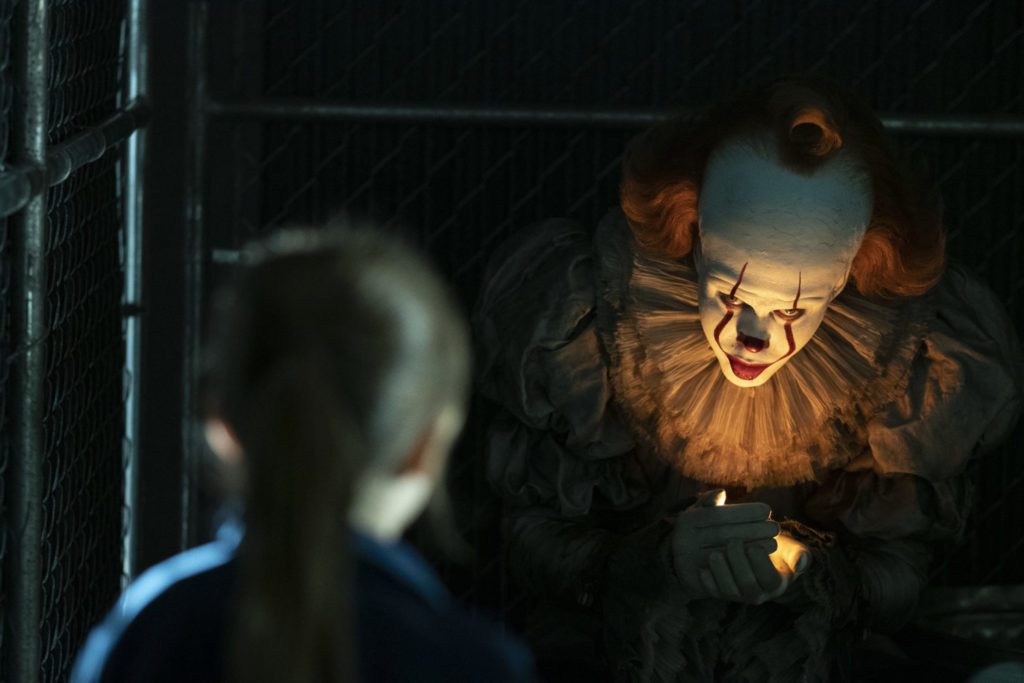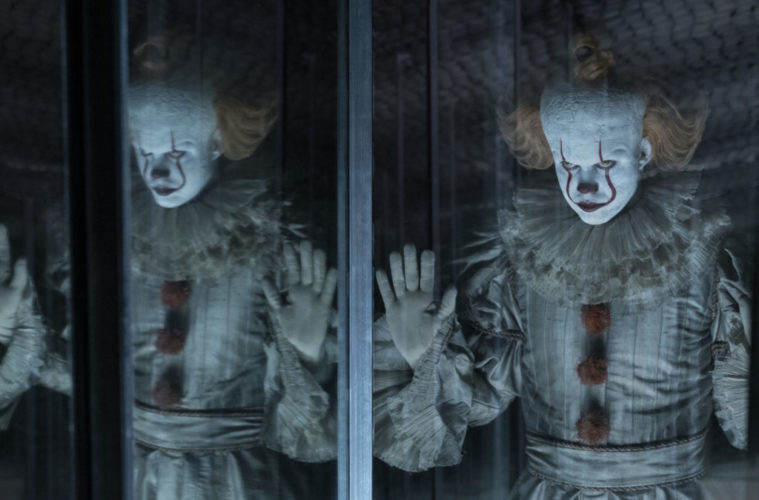Are kids still scared of clowns in 2016? According to Pennywise the Dancing Clown, not as much as they were in 1988. But after watching the almost three-hour long It Chapter Two — the follow up film to Warner Bros’ 2017 feature It — that may change. Directed by Andy Muschietti (Mama) and based on the famous Stephen King horror novel, both films boast Bill Skarsgård’s Pennywise, and he’s as evil, fun, horrific and entertaining as ever. Kids may be a bit smarter in 2016 and their demons, both internal and external, may be a bit more complex, but a good creepy clown clearly still evokes frights.
It Chapter Two takes place in 2016, exactly 27 years after the events of It, when the Losers Club is all grown up and each moved away from their hometown of Derry, Maine. All except one, that is. When Pennywise returns for his pillaging and murder of the town’s children every 27 years, Mike (Isaiah Mustafa), the only Loser left in Derry, calls his friends and asks them to return to help him kill the clown from their nightmares once and for all.
The 1986 1,100+ page novel simultaneously alternates between the time periods of 1957-58 (when the Losers Club were kids) and 1984-85 (when they’re grown up), constantly jumping back and forth between the two timelines. The 1990 television miniseries starring Tim Curry as Pennywise retained this format. The new Warner Bros. movies shift these two time periods forward to 1988-89 and 2016, telling the story not simultaneously but in two parts. The Losers’ childhood period was covered in the first film and their adulthood is in the second. This both helps and hurts the film.
On the positive end, the format change allowed for 2017’s It to focus on being a horror coming-of-age film by only telling the stories of the characters as kids. It made the audience even more excited for the sequel to see how these characters grew up and how the adult actors would portray the kids we fell in love with from the first film. On the other hand, it made one linear story get split into two, essentially causing the filmmakers to retell the same story twice: a group of lovable misfits unites (or reunites), Pennywise haunts them each individually, they band together as a group to try and stop him. In fact, there are a lot more flashbacks to the characters’ childhoods in Chapter Two than expected, making it seem like the time split really didn’t work very effectively.

Bill Skarsgård’s Pennywise aint clowning around this time. (Brooke Palmer/Warner Bros.)
However, it’s a solid story and the scares are legit so the audience probably won’t mind. After all, most sequels are basically retreads of the original’s story anyway. But both of these films came from a single novel much like the last two Hunger Game or Harry Potter movies, so the regular rules about sequels don’t apply here. And considering the length of the film, there was still a surprising amount of content cut and even some questions left unanswered. Bill (James McAvoy) and Beverly (Jessica Chastain) both start off the film in separate relationships, with Beverly in a bad, abusive one. In the novel, their significant others follow them to Derry, but in this film, we never hear from or see these significant others again. Perhaps less playing around with the format could help plug up some of these smaller plot holes.
The actors playing adult counterparts of the Losers Club all give outstanding, believable performances as grown versions of children from the first film, especially Saturday Night Live alum Bill Hader, who plays Richie (played by Stranger Things’ Finn Wolfhard as a child in the 2017 movie). Hader brings a perfect balance of comedic edge to the film in moments where it’s needed most. The film is definitely scary and has all sorts of terrifying images I’ve never seen done this well before on screen, but Hader brings some laughs to balance that out.
In fact, Hader and his character are involved in one of the biggest changes in this film adaptation, which for the most part is otherwise loyal to the novel minus a few miscellaneous plot points.
Warning for spoiler alert ahead…

The Losers Club all grown up. (Brooke Palmer/Warner Bros.)
It’s revealed in the film that Hader’s character, Richie, is attracted to men, something that Pennywise tries to use against him. This is an incredibly progressive move on the part of the filmmakers that should definitely be applauded. Representation matters, so it’s great to see some LGBTQ inclusion in a mainstream horror film like It. But the story arc also brings some disappointment. It is also revealed that Richie was in love with his friend Eddie (James Ransone). He’s unable to tell him how he feels because Eddie dies (he dies in the book as well, so this isn’t a huge spoiler for those who have read it). Eddie is married to a woman so he most likely isn’t gay, although there is a chance he could be bi, closeted or confused, right? Either way, Richie doesn’t have the chance to tell him and Eddie doesn’t have the chance to reciprocate Richie’s feelings or let him know if he ever felt the same. Representation is one thing, but clearly we haven’t gotten to the point where homosexuals are afforded happily ever after endings like heterosexual people are on film. Between Richie’ internal struggles with his sexuality, the death of his love/friend Eddie and the gay-bashing at the beginning of the film, which is also in the novel (but was cut from the 1990 miniseries), It Chapter Two could be a bit triggering for the LGBTQ community. We just want a happy ending every once in a while just like everyone else!
And if you’re thinking, “but it’s a horror movie, there are no happily-ever-afters,” that’s not at all true for the characters in It. Ben (Jay Ryan) ends up with Beverly (Jessica Chastain) — and again, this isn’t a huge spoiler as it happens in the book as well, but it’s telling that the writers made the gay storyline unrequited, but left this cliched part of the source material alone. The familiar narrative of the former fat kid finally getting the girl only after becoming good looking and successful comes off almost tone deaf in 2019. Have we not evolved beyond body-shaming stereotypes at this point?
Overall, however, It Chapter Two is an update that works. In fact, it’s one of the most entertaining and well-made horror films in recent memory. The CGI is fantastic, the characters are compelling and the acting is spot on. There’s a fun cameo fans will enjoy too!
At the end of the film the Losers Club proclaim that they’ll always be Losers; they finally embrace it and find pride in being themselves. As a whole new generation of “losers” gets to experience It for the first time through modern/millennial lenses, the progress that we’ve made as a society since the novel’s 1986 release in terms of appreciating our differences becomes part of the message here, and despite some shortcomings, that’s beautiful to see. We still have a long way to go, but perhaps in 27 more years kids watching It won’t even understand what being branded a loser feels like. Either way, they’ll probably still be afraid of clowns.
Advertising disclosure: We may receive compensation for some of the links in our stories. Thank you for supporting Irvine Weekly and our advertisers.

